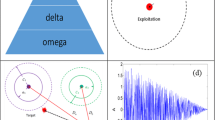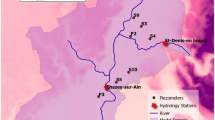Abstract
Ground management problems are typically solved by the simulation-optimization approach where complex numerical models are used to simulate the groundwater flow and/or contamination transport. These numerical models take a lot of time to solve the management problems and hence become computationally expensive. In this study, Artificial Neural Network (ANN) and Particle Swarm Optimization (PSO) models were developed and coupled for the management of groundwater of Dore river basin in France. The Analytic Element Method (AEM) based flow model was developed and used to generate the dataset for the training and testing of the ANN model. This developed ANN-PSO model was applied to minimize the pumping cost of the wells, including cost of the pipe line. The discharge and location of the pumping wells were taken as the decision variable and the ANN-PSO model was applied to find out the optimal location of the wells. The results of the ANN-PSO model are found similar to the results obtained by AEM-PSO model. The results show that the ANN model can reduce the computational burden significantly as it is able to analyze different scenarios, and the ANN-PSO model is capable of identifying the optimal location of wells efficiently.



Similar content being viewed by others
Abbreviations
- C wi :
-
Well installation cost (euros)
- C pn :
-
Capitalized cost of pipelines (euros)
- C p :
-
Total cost of pumping (euros)
- C pE :
-
Capitalized electricity cost (pumping cost)
- C pu :
-
Cost of pump units (euros)
- G t :
-
Global best value among all particles, gbest
- h i :
-
Minimum water head on the periphery of the i th well (m)
- b :
-
Aquifer thickness (m)
- K :
-
Hydraulic conductivity (m/s)
- L i :
-
Pipe length for each well (m)
- N w :
-
Total number of wells
- P t :
-
Previous best value for each particle, pbest
- Q :
-
Discharge from well (m3/s)
- Q i :
-
Discharge from i th well (m3/s)
- r :
-
The rate of interest (euros/euros/year)
- R E :
-
The cost of the electricity per kilowatt-hour (euros/kwh)
- V max :
-
Maximum velocity (m/s)
- W :
-
Complex discharge function
- Ψ :
-
Stream function (m3/s)
- Ω :
-
Rate of groundwater flow (m3/s)
- h :
-
Groundwater head (m)
- Ф :
-
Discharge potential (m3/s)
- ω :
-
Inertia weight
- γ :
-
Density of the fluid (N/m3)
- η :
-
Combined efficiency of the pump and the prime mover
References
Anmala J, Zhang B, Govindaraju RS (2000) Comparison of ANNs and empirical approaches for predicting watershed runoff. J Water Res Plan Manag 126:156–166
Arndt O, Barth T, Freisleben B, Grauer M (2005) Approximating a finite element model by neural network prediction for facility optimization in groundwater engineering. Eur J Oper Res 166:769–781
Artigue G, Johannet A, Borrell V, Pistre S (2012) Flash flood forecasting in poorly gauged basins using neural networks: case study of the Gardon de Mialet basin (southern France). Nat Hazards Earth Syst Sci 12:3307–3324
ASCE Task Committee on Application of Artificial Neural Networks in Hydrology (2000) Artificial neural networks in hydrology. I: preliminary concept. J Hydrol Eng 5(2):115–123
Atiya A, Ji C (1997) How initial conditions affect generalization performance in large networks. IEEE Trans Neural Netw 8(2):448–451
Chang L-C, Chu H-J, Hsiao C-T (2012) Integration of optimal dynamic control and neural network for groundwater quality management. Water Resour Manag 26(5):1253–1269
Coppola E, Poulton M, Charles E, Dustman J (2003) Application of artificial neural networks to complex groundwater management problems. Int Assoc Math Geol 12(4):303–320
Eberhart R, Kennedy J (1995) Particle swarm optimization. Proceedings of the IEEE, International Conference on Neural Networks
Gaur S, Chahar BR, Graillot D (2011) Analytic elements method and particle swarm optimization based simulation optimization model for groundwater management. J Hydrol 402(3):217–227
Hagan MT, Demuth HP, Beale M (1996) Neural network design. PWS Publishing, Boston
Han SP, Mangasarian OL (1979) Exact penalty functions in nonlinear programming. Math Program 17(1):251–269
Hsu KL, Gupta HV, Sorooshian S (1995) Artificial neural network modeling of the rainfall-runoff process. Water Resour Res 31:2517–2530
Johnson VM, Rogers LL (1995) Location analysis in ground-water remediation using neural networks. Ground Water 33(5):749–758
Karthikeyan L, Nagesh Kumar D, Graillot D, Gaur S (2012) Prediction of ground water levels in the uplands of a tropical coastal riparian wetland using artificial neural networks, water resources management, in print
Math Works Inc. (2001) MATLAB V R2009a, Apple Hill Drive, Natick, Massachusetts, USA
Matott LS, Rabideau AJ, Craig JR (2006) Pump-and-treat optimization using analytic element models. Adv Water Resour 29:760–775
McCulloch WS, Pitts W (1943) A logical calculus of the ideas imminent in nervous activity. Bull Math Biophys 5:115–133
Moradi JM, Marino MA, Afshar A (2003) Optimal design and operation of irrigation pumping station. J Irrig Drain Eng 129(3):149–154
Morshed J, Kaluarachchi JJ (1998) Application of artificial neural network and genetic algorithm in flow and transport simulations. Adv Water Resour 22(2):145–158
Nikolos IK, Stergiadi M, Papadopoulou MP, Karatzas GP (2008) Artificial neural networks as an alternative approach to groundwater numerical modelling and environmental design. Hydrol Process 22:3337–3348
Ranjithan S, Eheart JW, Garrett JH Jr (1993) Neural network based screening for groundwater reclamation under uncertainty. Water Resour Res 29(3):563–574
Rao SVN, Thandaveswara BS, Murty BS, Srinivasulu V (2003) Optimal groundwater management in deltaic regions using simulated annealing and neural networks. Water Resour Manag 17(6):409–428
Rogers LL, Dowla FU (1992) Groundwater remediation optimization with artificial neural networks and the genetic algorithm (abstract). EOS Trans Am Geophys Union 73(43):186, Fall Meeting
Rogers LL, Dowla FU (1994) Optimization of groundwater remediation using artificial neural networks with parallel solute transport modeling. Water Resour Res 30(2):457–481
Rogers LL, Dowla FU, Johnson VM (1995) Optimal field scale groundwater remediation using neural networks and the genetic algorithm. Environ Sci Technol 29(5):1145–1155
Rumelhart DE, McClelland JL (1986) The PDP Research Group. Parallel distributed processing: explorations in the microstructure of cognition, vol 1. MIT Press, Cambridge
Sharma AK, Swamee PK (2006) Cost considerations and general principles in the optimal design of water distribution systems. ASCE Conf Proc 247:85
Singh RM, Datta B, Jain A (2004) Identification of unknown groundwater pollution sources using artificial neural networks. J Water Resour Plan Manag 130(6):506–514
Sreekanth J, Datta B (2011) Comparative evaluation of genetic programming and neural network as potential surrogate models for coastal aquifer management. Water Resour Manag 25(13):3201–3218
Strack ODL (1989) Groundwater mechanics. Prentice-Hall, Englewood Cliffs
Swamee PK, Sharma AK (1990) Decomposition of large water distribution systems. J Environ Eng 116(2):269–283
Trichakis IC, Nikolos IK, Karatzas GP (2011) Artificial neural network (ANN) based modeling for karstic groundwater level simulation. Water Resour Manag 25(4):1143–1152
Author information
Authors and Affiliations
Corresponding author
Rights and permissions
About this article
Cite this article
Gaur, S., Ch, S., Graillot, D. et al. Application of Artificial Neural Networks and Particle Swarm Optimization for the Management of Groundwater Resources. Water Resour Manage 27, 927–941 (2013). https://doi.org/10.1007/s11269-012-0226-7
Received:
Accepted:
Published:
Issue Date:
DOI: https://doi.org/10.1007/s11269-012-0226-7




